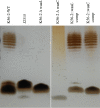A Broad-Host-Range Tailocin from Burkholderia cenocepacia
- PMID: 28258146
- PMCID: PMC5411513
- DOI: 10.1128/AEM.03414-16
A Broad-Host-Range Tailocin from Burkholderia cenocepacia
Abstract
The Burkholderia cepacia complex (Bcc) consists of 20 closely related Gram-negative bacterial species that are significant pathogens for persons with cystic fibrosis (CF). Some Bcc strains are highly transmissible and resistant to multiple antibiotics, making infection difficult to treat. A tailocin (phage tail-like bacteriocin), designated BceTMilo, with a broad host range against members of the Bcc, was identified in B. cenocepacia strain BC0425. Sixty-eight percent of Bcc representing 10 species and 90% of non-Bcc Burkholderia strains tested were sensitive to BceTMilo. BceTMilo also showed killing activity against Pseudomonas aeruginosa PAO1 and derivatives. Liquid chromatography-mass spectrometry analysis of the major BceTMilo proteins was used to identify a 23-kb tailocin locus in a draft BC0425 genome. The BceTMilo locus was syntenic and highly similar to a 24.6-kb region on chromosome 1 of B. cenocepacia J2315 (BCAL0081 to BCAL0107). A close relationship and synteny were observed between BceTMilo and Burkholderia phage KL3 and, by extension, with paradigm temperate myophage P2. Deletion mutants in the gene cluster encoding enzymes for biosynthesis of lipopolysaccharide (LPS) in the indicator strain B. cenocepacia K56-2 conferred resistance to BceTMilo. Analysis of the defined mutants in LPS biosynthetic genes indicated that an α-d-glucose residue in the core oligosaccharide is the receptor for BceTMilo.IMPORTANCE BceTMilo, presented in this study, is a broad-host-range tailocin active against Burkholderia spp. As such, BceTMilo and related or modified tailocins have potential as bactericidal therapeutic agents against plant- and human-pathogenic Burkholderia.
Keywords: Burkholderia cenocepacia; LPS; broad host range; receptor; tailocin.
Copyright © 2017 Yao et al.
Figures








Similar articles
-
The Mla Pathway Plays an Essential Role in the Intrinsic Resistance of Burkholderia cepacia Complex Species to Antimicrobials and Host Innate Components.J Bacteriol. 2018 Aug 24;200(18):e00156-18. doi: 10.1128/JB.00156-18. Print 2018 Sep 15. J Bacteriol. 2018. PMID: 29986943 Free PMC article.
-
Comparative Genomics and Evolutionary Analysis of RNA-Binding Proteins of Burkholderia cenocepacia J2315 and Other Members of the B. cepacia Complex.Genes (Basel). 2020 Feb 21;11(2):231. doi: 10.3390/genes11020231. Genes (Basel). 2020. PMID: 32098200 Free PMC article.
-
Molecular approaches to pathogenesis study of Burkholderia cenocepacia, an important cystic fibrosis opportunistic bacterium.Appl Microbiol Biotechnol. 2011 Dec;92(5):887-95. doi: 10.1007/s00253-011-3616-5. Epub 2011 Oct 14. Appl Microbiol Biotechnol. 2011. PMID: 21997606 Review.
-
Genomic characterization of JG068, a novel virulent podovirus active against Burkholderia cenocepacia.BMC Genomics. 2013 Aug 27;14:574. doi: 10.1186/1471-2164-14-574. BMC Genomics. 2013. PMID: 23978260 Free PMC article.
-
Burkholderia cenocepacia in cystic fibrosis: epidemiology and molecular mechanisms of virulence.Clin Microbiol Infect. 2010 Jul;16(7):821-30. doi: 10.1111/j.1469-0691.2010.03237.x. Clin Microbiol Infect. 2010. PMID: 20880411 Review.
Cited by
-
Drug discovery through the isolation of natural products from Burkholderia.Expert Opin Drug Discov. 2021 Jul;16(7):807-822. doi: 10.1080/17460441.2021.1877655. Epub 2021 Jan 29. Expert Opin Drug Discov. 2021. PMID: 33467922 Free PMC article. Review.
-
Phage therapy to treat cystic fibrosis Burkholderia cepacia complex lung infections: perspectives and challenges.Front Microbiol. 2024 Oct 18;15:1476041. doi: 10.3389/fmicb.2024.1476041. eCollection 2024. Front Microbiol. 2024. PMID: 39493847 Free PMC article. Review.
-
The role of multispecies social interactions in shaping Pseudomonas aeruginosa pathogenicity in the cystic fibrosis lung.FEMS Microbiol Lett. 2017 Aug 15;364(15):fnx128. doi: 10.1093/femsle/fnx128. FEMS Microbiol Lett. 2017. PMID: 28859314 Free PMC article. Review.
-
A VersaTile Approach to Reprogram the Specificity of the R2-Type Tailocin Towards Different Serotypes of Escherichia coli and Klebsiella pneumoniae.Antibiotics (Basel). 2025 Jan 18;14(1):104. doi: 10.3390/antibiotics14010104. Antibiotics (Basel). 2025. PMID: 39858389 Free PMC article.
-
Pseudomonas chlororaphis Produces Multiple R-Tailocin Particles That Broaden the Killing Spectrum and Contribute to Persistence in Rhizosphere Communities.Appl Environ Microbiol. 2018 Aug 31;84(18):e01230-18. doi: 10.1128/AEM.01230-18. Print 2018 Sep 15. Appl Environ Microbiol. 2018. PMID: 30030224 Free PMC article.
References
-
- Tablan OC, Chorba TL, Schidlow DV, White JW, Hardy KA, Gilligan PH, Morgan WM, Carson LA, Martone WJ, Jason JM, et al. . 1985. Pseudomonas cepacia colonization in patients with cystic fibrosis: risk factors and clinical outcome. J Pediatr 107:382–387. doi:10.1016/S0022-3476(85)80511-4. - DOI - PubMed
-
- Thomassen MJ, Demko CA, Klinger JD, Stern RC. 1985. Pseudomonas cepacia colonization among patients with cystic fibrosis. A new opportunist. Am Rev Respir Dis 131:791–796. - PubMed
MeSH terms
Substances
Grants and funding
LinkOut - more resources
Full Text Sources
Other Literature Sources
Medical
Research Materials
Miscellaneous

